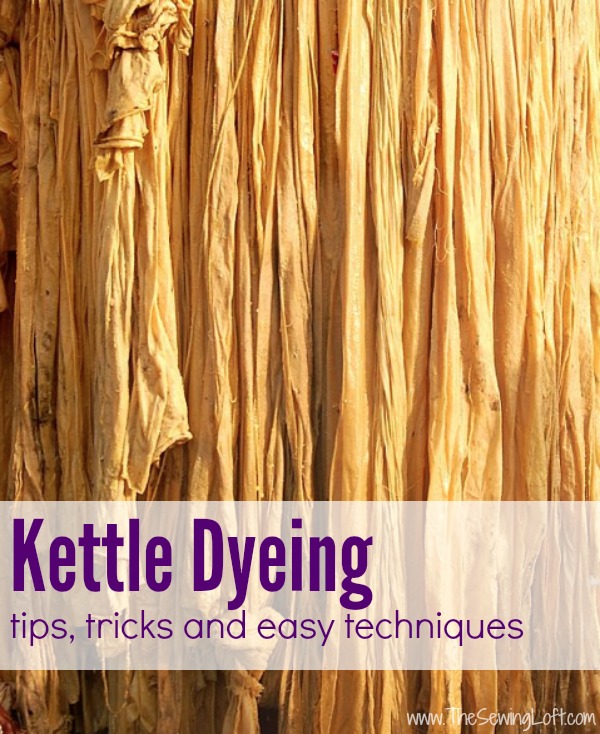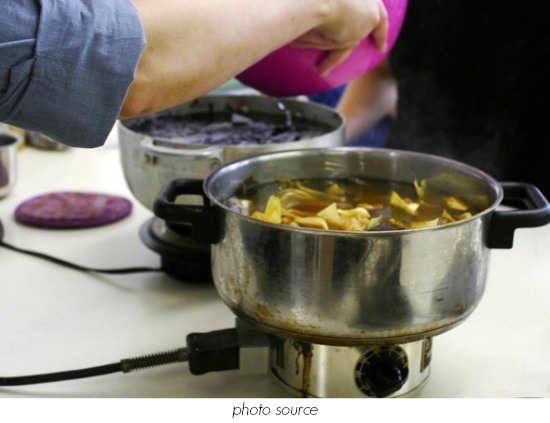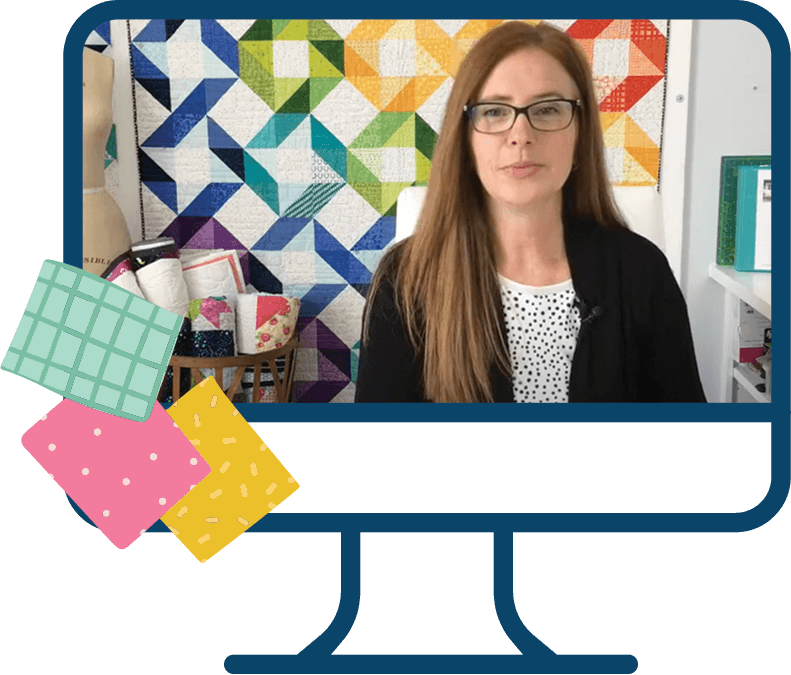Kettle dyeing your fabric gives slightly less predictable results, but with a little practice it can be an excellent way to create beautiful, variegated designs onto your fabrics. This method will work best with an undyed fabric, such as unbleached muslin or undyed silk scarves.
Gather your materials:
In order to kettle dye fabric at home, you will need:
- a stock pot
- a large wooden or plastic stirring spoon or paint stirring stick (again, not for food use)
- a strainer
- a small spoon
- an old towel or rag or several paper towels
- powered fabric dyes (Rit for cotton, Jacquard for wool or silk)
- fabric for dyeing or a garment such as a shirt
- protective clothing
**Not all of the above items should NOT be used for food after dyeing!
How to Kettle Dye Fabric
1. Prepare the dye bath.
Heat up a bath of water in a large pot on your stovetop. The water should be hot but not boiling (bring it to a simmer). Remember: you cannot use this pot again for food products, so go find one at a thrift store that you will reserve just for crafting.
Tip: If you’re using certain kinds of dyes they may call for an acid or a mordant to set the dye. Include this acid or mordant in the water bath before adding the fabric. For Jacquard dyes, use a healthy splash of vinegar in every dye bath.
2. Soak the fabric.
Submerge your fabric into the hot water and use your spoon or stirring stick to poke it down until it is fully saturated.
3. Add the dye.
Use a small spoon (a plastic restaurant spoon works well for this, or a measuring spoon you won’t use for food again) to scoop up a VERY small amount of dye; sprinkle this dye onto the fabric. Use your spoon to push the dye into the fabric until it soaks in.
Tip: Less is always more in this process. You can always add more dye to get more color, but if you over-do it the dye will spread quickly and potentially ruin the fabric. Repeat this step with other colors of dye until your fabric is fully colored the way you want it to be.
4. Simmer.
Turn down the heat to medium-low and allow the fabric to simmer on the stove for approximately 10 to 15 minutes in order to fully set the dye.
5. Rinse.
Place your strainer in the sink and pour the dye bath out over the strainer, catching the fabric in the strainer. Rinse the fabric with cool water until the water runs clear and the excess dye rinses out. Hang it up to dry or wash and dry as normal.
I found some great how to videos on YouTub. Check out this video from DevineDIY and this one with Mary from Camaj Handspun Yarn. She has an awesome tip on keeping your counters clean but videos are a perfect example of kettle dyeing. Kettle dyeing creates a soft, blended color combination that often resembles batik style fabrics. Try it out and see what you can create, and then show it off in the Sewing Loft Flickr Pool!
Fabric Dyeing Mini Series Round Up-
Come back next time where we’ll combine fabric dyeing and painting methods to create something new!
Hello! Are you new to The Sewing Loft?
If so, I’m glad you stopped by and hope that something has inspired you to keep your needle moving! Don’t miss a single project and subscribe via email HERE! Bonus- free embroidery pattern with newsletter sign up. Another great way to connect with me is via Facebook, Pinterest, Twitter, Google+ or Follow my blog with Bloglovin. I’m looking forward to getting to know you and creating together!






Comments & Reviews
Thank you for having this site! I am 65 & have been what I call a beginner level sewing for about 46 to 47 years now. I am wondering if any one else is in my sewing block? I have always loved seeing for myself, my husband, 3 sons when they were little and our five granddaughters. I lost my husband after 43 + yr. and now have to actually force myself to sew. I seem to have lost almost all my desire to sew, yet I still am adding to my “stash”. After Bob died I moved to Ohio & I like it here, have a 10 x 10 bedroom for sewing, can’t go in it hardly at all. It is so disorganized and down right messy I am feeling just empty of wanting to make it right. Some one who knows me and knew Bob said it could be because during the last 3 years I made his shirts with fabric he would pick out. Before that I had to darn near hog tie him to go near a fabric store. Please am I the only one who’s going through this? I’m not looking for sympathy, I’m just trying to help myself back up. Thanks for listening to me!
Dottie